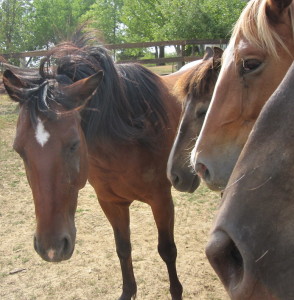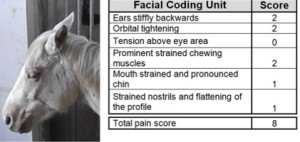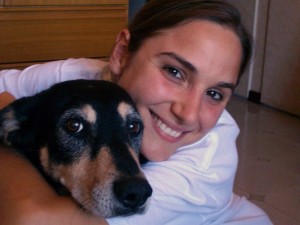By Maddy Butcher
Horses don’t speak, but we can ‘hear’ what they’re telling us if we pay attention. That’s what pinned ears, tail  swishing, and lip-licking are all about. Problems arise, though, with the our interpretations: one person can hear something different than the next.
swishing, and lip-licking are all about. Problems arise, though, with the our interpretations: one person can hear something different than the next.
Temple Grandin recognized that subjectivity in the cattle industry, where terms like “Properly,” “Adequate,” “Sufficient,” and “Undue Pain and Suffering” once ruled the day.
“What do those terms mean?” she asked rhetorically.
Grandin helped bring measurable protocol to stockyards and slaughter facilities. As a result of her research and lobbying, an increasing number of plants and individual handlers are now scored on the percentage of animals in their care that run, fall, vocalize, and are moved by electric prod. She has arguably made that world a better place for those animals in their final moments. Read article.
Now, researchers have taken crucial steps in quantifying what horses ‘say’ about pain. In the recently published “Development of the Horse Grimace Scale (HGS) as a Pain Assessment Tool in Horses Undergoing Routine Castration“ an international team of scientists developed protocol for assessing and measuring horse pain as interpreted through facial expressions. Read their research.
They monitored forty stallions undergoing castration. The studs were divided into two groups, receiving different medications before and after surgery. Another six horses were monitored and managed similarly, but did not undergo surgery. (They had their teeth floated or hooves trimmed.)
The changes in facial expressions were assessed and ranked using the Horse Grimace Scale before and after castration. The Horse Grimace Scale (HGS) asks, for example:
- Are chewing muscles strained?
- Are nostrils strained?
- Is there tightening around the eye?
- Are the ears back?
The group recorded video footage with two cameras in each stall and selected random still frames to grade the presence or absence of six indicators. Five trained observers evaluated and scored the facial expressions. The researchers pooled and tabulated the results, arriving at HGS scores for all of the horses, before, during, and after the procedures.
Only horses undergoing castration showed high HGS scores.
Does this study mean that ranchers, who routinely castrate horses in the field with no sedation or painkillers, are going to change their ways?
Probably not.
Might the findings lead to increased scrutiny of those practices which ignore or fail to acknowledge horses’ suffering?
Maybe.
Can it help vets, vet techs, trainers, and us Regular Joe horse owners with identifying horses’ discomfort in a wide array of scenarios?
For sure.
Horses don’t fake it. We can take their expressions at face value and infer that they are experiencing pain. We also assume that heart rate and blood cortisol levels increase with pain. It should be noted that the researchers also collected heart rate and other physiological data in order to study the relationship of those changes with facial expression changes.
Developing a standard to recognize pain in horses is an excellent step towards treating them more humanely. In addition, the Horse Grimace Scale is easy to understand and requires no special equipment. Everyone – from veterinarians to barn workers – can learn to identify HGS markers.
“I think that pain assessment in animals is really difficult and probably this is the reason why it is often underestimated. I hope that this study can help people to understand that horses can suffer from painful conditions,” said Dr. Emanuela Dalla Costa, co-author of the study, and a veterinarian and PhD at the University of Milan.
“Horses are a very expressive species. They communicate their emotions and feelings not only with the body posture, but also with their facial expressions. I personally hope that this method can help horse owners in identifying and assessing pain.”



Perhaps, to change ranchers minds, they should be castrated without sedation and watch their faces.
Anyone today who cannot empathize with an animal having pain should not have the pivilegeof having an animal.